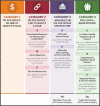The Next Generation of Payment Reforms for Population Health - An Actionable Agenda for 2035 Informed by Past Gains and Ongoing Lessons
- PMID: 37096610
- PMCID: PMC10126963
- DOI: 10.1111/1468-0009.12632
The Next Generation of Payment Reforms for Population Health - An Actionable Agenda for 2035 Informed by Past Gains and Ongoing Lessons
Abstract
Policy Points The predominantly fee-for-service reimbursement architecture of the US health care system contributes to waste and excess spending. While the past decade of payment reforms has galvanized the adoption of alternative payment models and generated moderate savings, uptake of truly population-based payment systems continues to lag, and interventions to date have had limited impact on care quality, outcomes, and health equity. To realize the promise of payment reforms as instruments for delivery system transformation, future policies for health care financing must focus on accelerating the diffusion of value-based payment, leveraging payments to redress inequities, and incentivizing partnerships with cross-sector entities to invest in the upstream drivers of health.
Keywords: alternative payment models; health care payments; value-based care.
© 2023 Milbank Memorial Fund.
Figures
Similar articles
-
Alternative Payment Models and Associations With Stroke Outcomes, Spending, and Service Utilization: A Systematic Review.Stroke. 2022 Jan;53(1):268-278. doi: 10.1161/STROKEAHA.121.033983. Epub 2021 Nov 3. Stroke. 2022. PMID: 34727742
-
Emerging lessons from regional and state innovation in value-based payment reform: balancing collaboration and disruptive innovation.Milbank Q. 2014 Sep;92(3):568-623. doi: 10.1111/1468-0009.12078. Milbank Q. 2014. PMID: 25199900 Free PMC article.
-
Advancing Primary Care Through Alternative Payment Models: Lessons from the United States & Canada.J Am Board Fam Med. 2018 May-Jun;31(3):322-327. doi: 10.3122/jabfm.2018.03.170297. J Am Board Fam Med. 2018. PMID: 29743214
-
Perspectives on evolving dental care payment and delivery models.J Am Dent Assoc. 2016 Jan;147(1):50-6. doi: 10.1016/j.adaj.2015.08.010. Epub 2015 Nov 6. J Am Dent Assoc. 2016. PMID: 26562730
-
How Evolving United States Payment Models Influence Primary Care and Its Impact on the Quadruple Aim.J Am Board Fam Med. 2018 Jul-Aug;31(4):588-604. doi: 10.3122/jabfm.2018.04.170388. J Am Board Fam Med. 2018. PMID: 29986985 Review.
Cited by
-
Patient experience with hospital care following the Maryland global budget revenue model: A difference-in-difference analysis.PLoS One. 2024 Aug 6;19(8):e0308331. doi: 10.1371/journal.pone.0308331. eCollection 2024. PLoS One. 2024. PMID: 39106261 Free PMC article.
-
Use of alternative payment models for substance use disorder prevention in the United States: development of a conceptual framework.Subst Abuse Treat Prev Policy. 2025 Jan 22;20(1):4. doi: 10.1186/s13011-025-00635-z. Subst Abuse Treat Prev Policy. 2025. PMID: 39844326 Free PMC article.
References
-
- Schneider EC, Shah A, Doty MM, Tikkanen R, Fields K, Williams RD III. Mirror Mirror 2021: Reflecting Poorly. New York, NY: The Commonwealth Foundation; 2021. https://www.commonwealthfund.org/publications/fund‐reports/2021/aug/mirr.... Accessed April 14, 2022.
-
- Poisal JA, Sisko AM, Cuckler GA, Smith SD, Keehan SP, Fiore JA, Madison AJ, Rennie KE. National health expenditure projections, 2021–30: growth to moderate as COVID‐19 impacts wane. Health Affairs. 2022;41(4):474‐486. - PubMed
-
- Shrank WH, Rogstad TL, Parek N. Waste in the US health care system: estimated costs and potential for savings. JAMA. 2019;322(15):1501‐1509. - PubMed
MeSH terms
LinkOut - more resources
Full Text Sources
Medical
Miscellaneous


